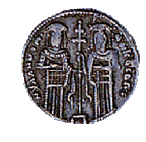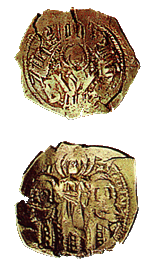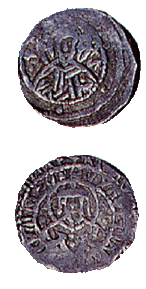 |
|
 |
Currency: names - form
 he currency
he currency
 of the late Byzantine period may be divided into three sub-periods. During the first sub-period (1204-1295) the coins still minted were the gold
hyperpyron, and the silver and the copper trachy ("rough"). of the late Byzantine period may be divided into three sub-periods. During the first sub-period (1204-1295) the coins still minted were the gold
hyperpyron, and the silver and the copper trachy ("rough").
During the joint reign of the Emperors
Andronikos II
and
Michael IX
(1294/5-1320) a new coin, the silver basilikon (from basileus,"king") was introduced. Thus, in the second sub-period (1295-1367), the gold coin in circulation was the hyperpyron, the silver coins
 were the basilikon (also known as argyrion or doukaton) and the hemi-basilikon (or argyridion), and there were also three copper coins: the tornikion, the concave stamenon ("standard") and the flat assarion. were the basilikon (also known as argyrion or doukaton) and the hemi-basilikon (or argyridion), and there were also three copper coins: the tornikion, the concave stamenon ("standard") and the flat assarion.
The reigns of
John V Palaiologos
(1341-1391) and
John VI Kantakouzenos
(1347-54) saw the minting of the last hyperpyron, in 11-carat gold. John V Palaiologos definitively replaced the gold hyperpyron with a larger silver coin, the stauraton, which had already circulated in 1366/67. Thus, in the period between 1367 and 1453, besides the gold hyperpyron, there were also the silver stauraton, the hemistauraton and the doukatopoulon (also known as the ducatello or aspron), and the copper tornikion and
 follaro. Certain names of Western origin, such as "doukaton", "tornikion" and "doukatopoulon" are indicative of the dominant position of the West and its great influence on economic and monetary matters. follaro. Certain names of Western origin, such as "doukaton", "tornikion" and "doukatopoulon" are indicative of the dominant position of the West and its great influence on economic and monetary matters.
The mint in Constantinople remained in operation until the end of the reign of
John VIII Palaiologos
(1425-1448). It was, however, briefly used in 1453, during the last siege of Constantinople, for the minting of the last Byzantine coin. This was the silver stauraton of
Constantine XI
(1449-53).
The obverse of the coins represented the Virgin Mary or Christ.
The reverse usually represented the reigning emperor or emperors, attired in formal dress, which made the coin an important means of political propaganda.
|